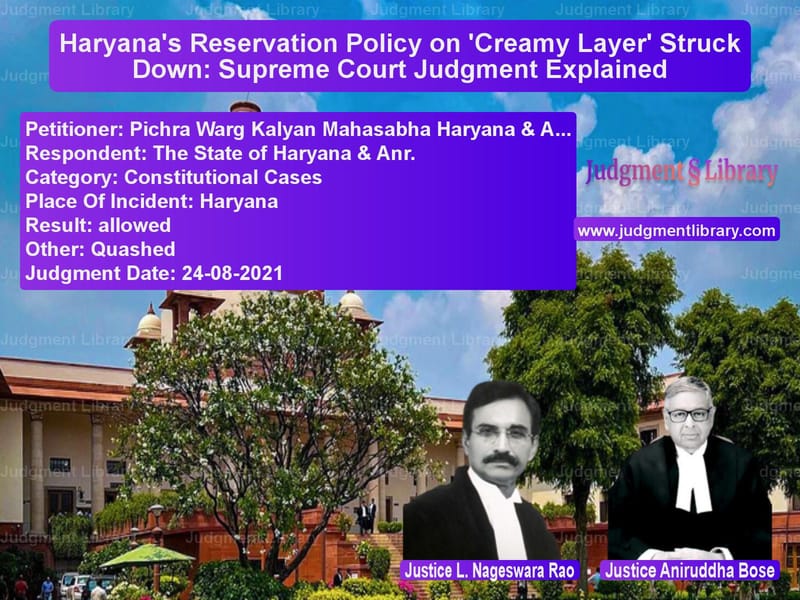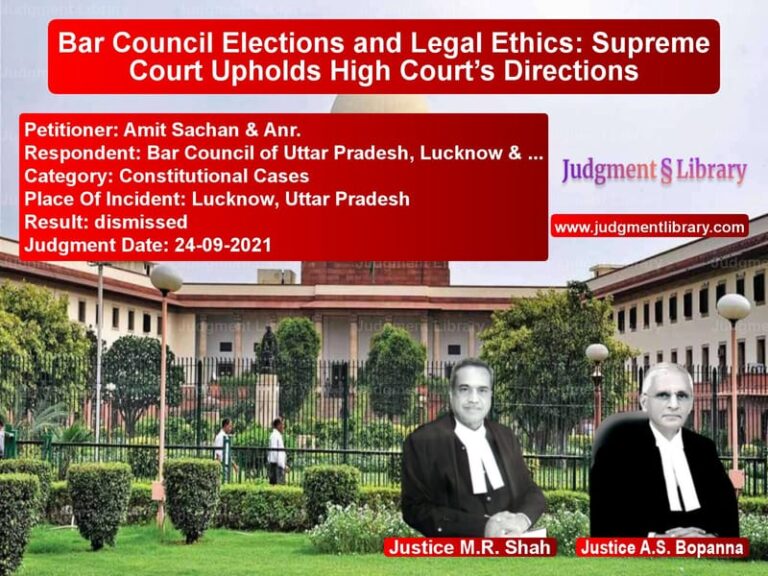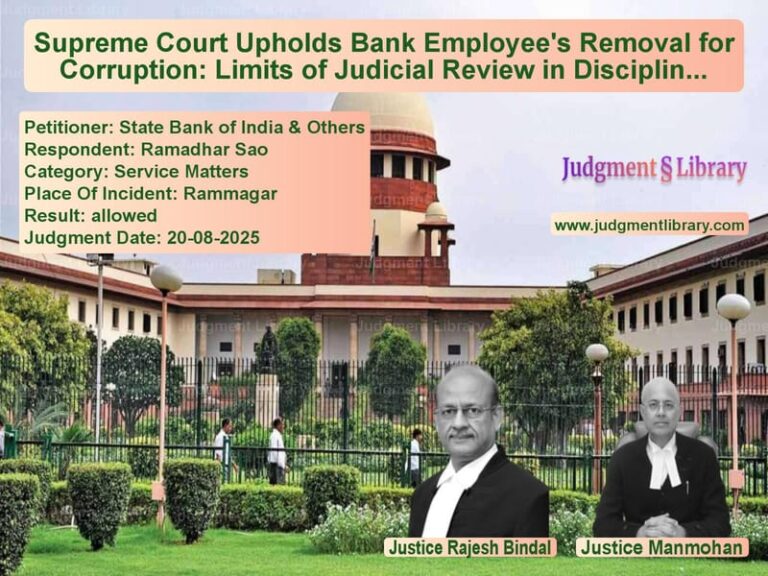Haryana’s Reservation Policy on ‘Creamy Layer’ Struck Down: Supreme Court Judgment Explained
The Supreme Court of India, in a significant ruling, quashed Haryana’s notifications defining the ‘creamy layer’ among backward classes solely on economic criteria. The judgment, delivered in Pichra Warg Kalyan Mahasabha Haryana & Anr. vs. The State of Haryana & Anr., reaffirmed the principle that social, economic, and other factors must be considered when determining eligibility for reservations.
The case arose from two notifications issued by the Haryana government—one dated 17.08.2016 and another 28.08.2018—seeking to redefine the identification of the ‘creamy layer’ among backward classes. The Supreme Court ruled these notifications unconstitutional, emphasizing that economic status alone cannot be the sole determinant of backwardness.
Background of the Case
The concept of reservations for backward classes in India has its roots in the recommendations of the Mandal Commission. The landmark judgment in Indra Sawhney vs. Union of India (1992) laid down the foundation for excluding the ‘creamy layer’ from the backward classes to ensure that the benefits of reservation reach the truly marginalized.
In response to this ruling, Haryana formed the Second Backward Classes Commission in 1993, which recommended criteria for identifying and excluding socially advanced individuals. Based on these recommendations, Haryana had historically excluded individuals holding high-ranking government posts, those with significant landholdings, and individuals with high wealth or income.
Key Notifications Under Challenge
- Notification dated 17.08.2016: This notification set an economic threshold for determining the ‘creamy layer.’ It stated that individuals earning more than ₹6 lakh per annum would be excluded from reservations. Additionally, it created a sub-classification within backward classes, giving priority to individuals earning less than ₹3 lakh annually.
- Notification dated 28.08.2018: This notification further altered the income computation method by mandating that all sources of income, including salary and agricultural income, be considered in determining whether a person falls within the ‘creamy layer.’
Arguments Presented by the Petitioners
The petitioners contended that the Haryana government’s notifications violated the principles set forth in Indra Sawhney. They argued:
“Economic criterion alone cannot be the sole basis for identifying the ‘creamy layer.’ Social and educational factors must also be considered.”
They further argued that by clubbing salary and agricultural income, the notifications unfairly excluded a large number of backward class members from reservations in government jobs and educational institutions.
Arguments Presented by the Respondents
The State of Haryana defended its notifications by arguing that:
“The sub-classification within backward classes ensures that the most disadvantaged sections receive priority in reservations.”
The government asserted that the decision was based on a detailed survey assessing the economic conditions of various backward classes.
Supreme Court’s Observations and Judgment
Justice L. Nageswara Rao, delivering the judgment, cited the ruling in Indra Sawhney and held that economic criteria alone are insufficient to determine backwardness. The Court observed:
“The exclusion of ‘creamy layer’ must be based on social and educational advancement, not just economic status.”
The Court further criticized Haryana’s attempt to sub-classify backward classes based solely on income levels, calling it arbitrary and discriminatory.
Final Verdict
The Supreme Court struck down the 17.08.2016 notification, declaring it unconstitutional. Since the 28.08.2018 notification was based on the earlier notification, it too was invalidated.
The Court directed the Haryana government to issue fresh criteria for identifying the ‘creamy layer’ within three months, ensuring compliance with constitutional principles.
Implications of the Judgment
- The ruling reinforces that economic criteria alone cannot define backwardness.
- States must ensure that reservation policies adhere to judicially established guidelines.
- Existing admissions and appointments based on the now-invalid notifications will remain unaffected.
This judgment reaffirms the principle that social and educational advancement, along with economic factors, must be considered in defining the ‘creamy layer’ to ensure that reservation benefits reach those who truly need them.
Petitioner Name: Pichra Warg Kalyan Mahasabha Haryana & Anr..Respondent Name: The State of Haryana & Anr..Judgment By: Justice L. Nageswara Rao, Justice Aniruddha Bose.Place Of Incident: Haryana.Judgment Date: 24-08-2021.
Don’t miss out on the full details! Download the complete judgment in PDF format below and gain valuable insights instantly!
Download Judgment: pichra-warg-kalyan-m-vs-the-state-of-haryana-supreme-court-of-india-judgment-dated-24-08-2021.pdf
Directly Download Judgment: Directly download this Judgment
See all petitions in Fundamental Rights
See all petitions in Constitution Interpretation
See all petitions in Public Interest Litigation
See all petitions in Judgment by L. Nageswara Rao
See all petitions in Judgment by Aniruddha Bose
See all petitions in allowed
See all petitions in Quashed
See all petitions in supreme court of India judgments August 2021
See all petitions in 2021 judgments
See all posts in Constitutional Cases Category
See all allowed petitions in Constitutional Cases Category
See all Dismissed petitions in Constitutional Cases Category
See all partially allowed petitions in Constitutional Cases Category







